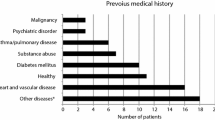Abstract
Cervical necrotizing fasciitis (CNF) is a life-threatening complication of pharyngeal or dental infections. The aim of this paper was to investigate whether dental or pharyngeal source result from different pathogen(s) in CNF and whether antibiotics, given before admission, influence the antimicrobial resistance of pathogens. In 152 CNF patients, Streptococcus milleri group and Prevotella species were the predominant isolates, frequently copathogens, mostly in dental CNF samples. Penicillin and clindamycin resistance were observed in 39% and 37% of cases, respectively, independently of any previous antibiotic therapy. Thus, a combined aerobe–anaerobe infection may have a synergistic effect, which allows the infection to spread in cervical tissues.
Similar content being viewed by others
References
Swartz MN (2004) Clinical practice. Cellulitis. N Engl J Med 350(9):904–912
Mathieu D, Neviere R, Teillon C, Chagnon JL, Lebleu N, Wattel F (1995) Cervical necrotizing fasciitis: clinical manifestations and management. Clin Infect Dis 21(1):51–56
Mohammedi I, Ceruse P, Duperret S, Vedrinne J, Boulétreau P (1999) Cervical necrotizing fasciitis: 10 years’ experience at a single institution. Intensive Care Med 25(8):829–834
Huang TT, Tseng FY, Yeh TH, Hsu CJ, Chen YS (2006) Factors affecting the bacteriology of deep neck infection: a retrospective study of 128 patients. Acta Otolaryngol 126(4):396–401
Okayama H, Nagata E, Ito HO, Oho T, Inoue M (2005) Experimental abscess formation caused by human dental plaque. Microbiol Immunol 49(5):399–405
Murray PR, Baron EJ, Pfaller MA, Tenover FC, Yolken RH (1999) Manual of clinical microbiology, 7th edn. ASM Press, Washington, DC, pp 1773
Fihman V, Raskine L, Barrou Z, Kiffel C, Riahi J, Berçot B, Sanson-Le Pors MJ (2006) Lactococcus garvieae endocarditis: identification by 16S rRNA and sodA sequence analysis. J Infect 52(1):e3–6
Belko J, Goldmann DA, Macone A, Zaidi AK (2002) Clinically significant infections with organisms of the Streptococcus milleri group. Pediatr Infect Dis J 21(8):715–723
Ruoff KL (1988) Streptococcus anginosus (“Streptococcus milleri”): the unrecognized pathogen. Clin Microbiol Rev 1(1):102–108
Wanahita A, Goldsmith EA, Musher DM, Clarridge JE 3rd, Rubio J, Krishnan B, Trial J (2002) Interaction between human polymorphonuclear leukocytes and Streptococcus milleri group bacteria. J Infect Dis 185(1):85–90
Macey MG, Whiley RA, Miller L, Nagamune H (2001) Effect on polymorphonuclear cell function of a human-specific cytotoxin, intermedilysin, expressed by Streptococcus intermedius. Infect Immun 69(10):6102–6109
Petersen FC, Pecharki D, Scheie AA (2004) Biofilm mode of growth of Streptococcus intermedius favored by a competence-stimulating signaling peptide. J Bacteriol 186(18):6327–6331
Brook I (2005) Bacteriology of acute and chronic ethmoid sinusitis. J Clin Microbiol 43(7):3479–3480
Hintao J, Teanpaisan R, Chongsuvivatwong V, Ratarasan C, Dahlen G (2007) The microbiological profiles of saliva, supragingival and subgingival plaque and dental caries in adults with and without type 2 diabetes mellitus. Oral Microbiol Immunol 22(3):175–181
Brook I, Frazier E (1995) Clinical and microbiological features of necrotizing fasciitis. J Clin Microbiol 33(9):2382–2387
Brook I, Walker RI (1984) Pathogenicity of anaerobic gram-positive cocci. Infect Immun 45(2):320–324
Nagashima H, Takao A, Maeda N (1999) Abscess forming ability of streptococcus milleri group: synergistic effect with Fusobacterium nucleatum. Microbiol Immunol 43(3):207–216
Brook I (2007) Microbiology and management of soft tissue and muscle infections. Int J Surg (in press) DOI 10.1016/j.ijsu.2007.07.001
Reynolds SC, Chow AW (2007) Life-threatening infections of the peripharyngeal and deep fascial spaces of the head and neck. Infect Dis Clin North Am 21(2):557–576 viii
Acknowledgments
We thank Benoit Schlemmer for his critical review and editorial guidance. We acknowledge the efforts of all of the members of the bacteriology department for their dedication and skill.
Author information
Authors and Affiliations
Corresponding author
Rights and permissions
About this article
Cite this article
Fihman, V., Raskine, L., Petitpas, F. et al. Cervical necrotizing fasciitis: 8-years’ experience of microbiology. Eur J Clin Microbiol Infect Dis 27, 691–695 (2008). https://doi.org/10.1007/s10096-008-0491-9
Received:
Accepted:
Published:
Issue Date:
DOI: https://doi.org/10.1007/s10096-008-0491-9




